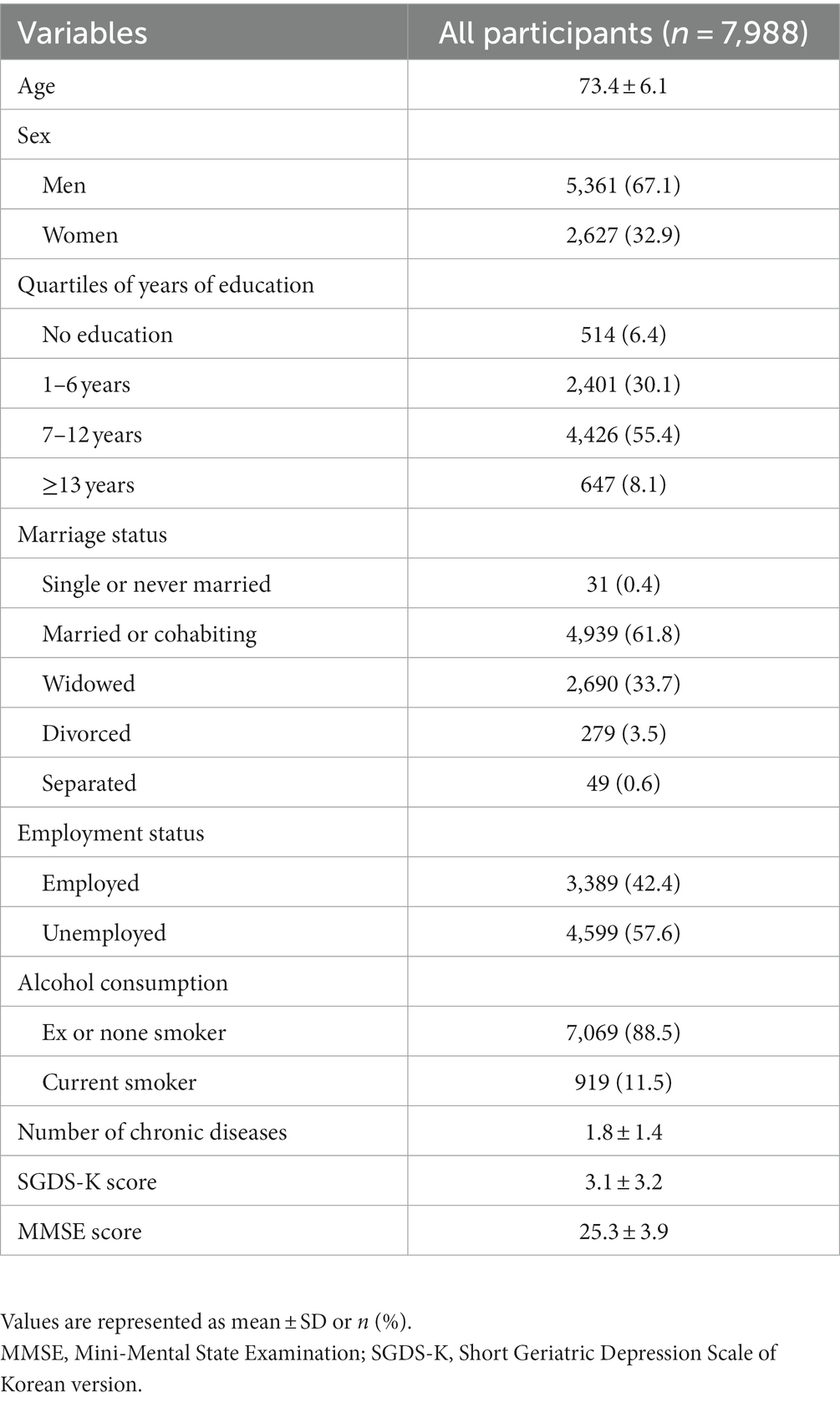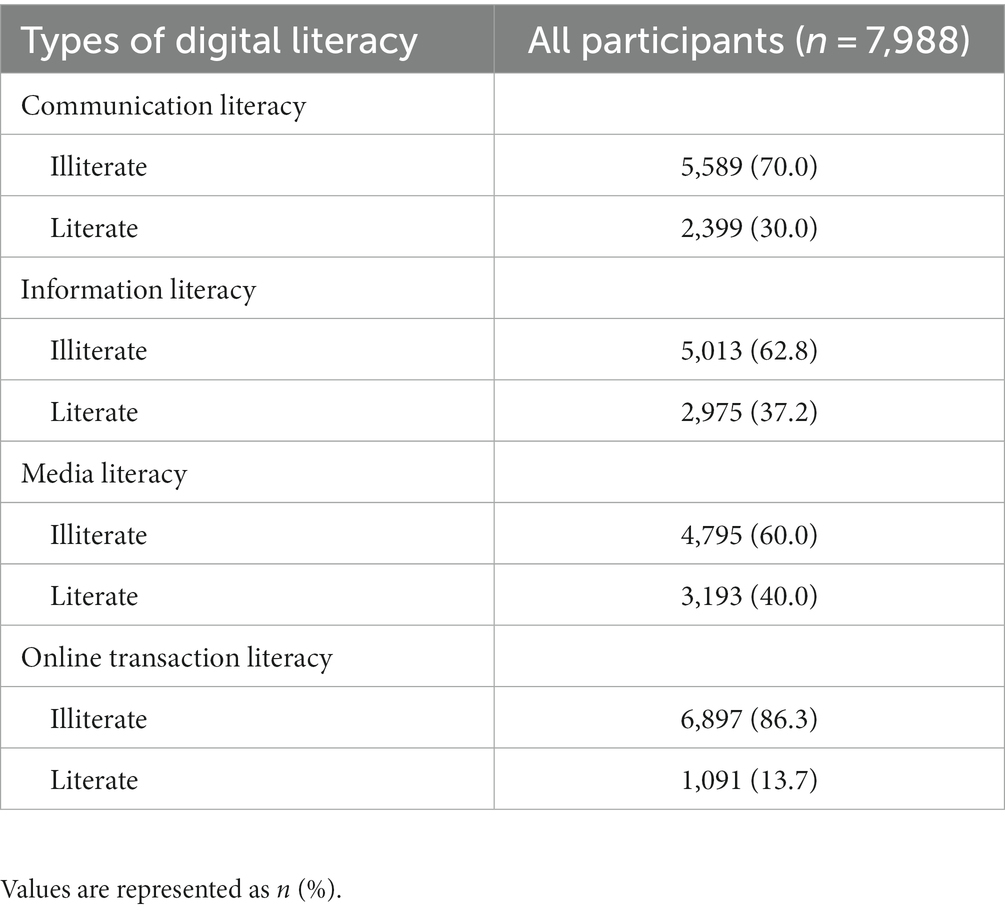- 1Department of Medicine, Gachon University School of Medicine, Incheon, Republic of Korea
- 2Department of Psychiatry, Ajou University School of Medicine, Suwon, Republic of Korea
Introduction: Although several studies have examined the individual relationships among digital literacy, cognitive function, and depressive symptoms, few have integrated all three factors into a single model. This study aimed to address this gap by investigating the mediating effect of depressive symptoms on the relationship between digital literacy and cognition. In doing so, we hoped to contribute to a more comprehensive understanding of the complex interplay among these variables and their implications for mental health and well-being.
Methods: Participants were 7,988 older adults (65 years or older) who participated in the Living Profiles of Older People Survey 2020. The main type of exposure was digital literacy (communication, information, media, and online transaction literacy). The main outcomes were depressive symptoms measured using the Short Geriatric Depression Scale of Korean version and cognitive function measured using the Mini-Mental State Examination score. Multiple linear regression and mediation analyses were also performed.
Results: After adjusting for covariates, our analysis found a significant association between digital literacy and both depressive symptoms and cognitive function (β of four types of digital literacy and depressive symptoms = −0.123, −0.172, −0.702, and − 0.639, respectively; β of four types of digital literacy and cognitive function = 2.102, 2.217, 1.711, and 1.436, respectively). Moreover, our study showed that depressive symptoms play a mediating role in the relationship between media and online transaction literacy and cognitive function (95% CI of indirect effects = 0.0647–0.1212 and 0.0639–0.1277, respectively), implying an indirect pathway (digital literacy, depressive symptoms, and cognitive function).
Discussion: This study sheds light on the relationship between digital literacy, depressive symptoms, and cognitive function in older adults. We found that depressive symptoms mediated the association between specific aspects of digital literacy (online transaction and media literacy) and cognitive function. Our results indicate that community-based digital literacy programs could be effective in reducing depression and preserving or improving cognitive function in older adults.
1. Introduction
The prevalence of dementia is projected to double every 20 years owing to an aging global population (1). Dementia is defined as a loss of memory, language, problem-solving skills, and other mental functions that impair a person’s ability to carry out daily tasks (2). Therefore, understanding the mechanistic pathways that lead to cognitive decline in older adults is a public health priority (3). Recent studies suggest that digital literacy is associated with cognitive functioning (4). Although extensive research has been directed toward the younger demographic (5, 6), there remains a paucity of studies centered on the elderly. It is pertinent to note that, for this older group, digital literacy might influence depression and cognitive function either positively or negatively. For example, digital literacy can potentially alleviate depression by fostering social connections and increasing access to mental health resources online (7, 8); in turn, reduced depression can enhance cognitive function by minimizing cognitive load and optimizing neural activity related to attention and memory (9, 10). The number of older adults who use digital devices, such as smartphones, has increased in many countries. In South Korea, among those aged 60 years or older, the percentage of smartphone users was 20% as of November 2012 and 76% as of July 2019 (11).
As the world population ages rapidly, depression has become a major public health concern among older adults (12). Depression affects not only the quality of life but also the physical and cognitive functioning of older adults (13). Recent studies suggest that the use of digital devices may serve as a protective factor against depression (14). The protective effects of digital literacy involve various possible psychological mechanisms, including increased neural plasticity and neurochemical modulation, as well as psychosocial mechanisms, including a sense of mastery and life satisfaction (15, 16).
Although depression is known to affect cognitive function, there is a strong likelihood that these three factors (digital literacy, cognitive function, and depressive symptoms) are closely connected (17, 18). Many studies have investigated the individual relationships among digital literacy, depression, and cognitive function in older adults (19). However, few studies have integrated all three factors into a single model, leaving a gap in our understanding of the complex interplay among these variables. Thus, the primary objective of this study was to evaluate the mediating effect of depressive symptoms on the relationship between digital literacy and cognitive function in a large sample of older adults in South Korea. By doing so, this study aimed to provide crucial insights into the potential factors contributing to mental health issues among older adults and inform targeted interventions to improve their digital literacy skills, cognitive function, and overall well-being.
2. Materials and methods
2.1. Participants
In the present study, 10,097 individuals aged 65 years or older who participated in the Living Profiles of Older People Survey (LPOPS) 2020 were selected. From September 14, 2020, to November 20, 2020, LPOPS 2020 constituted a comprehensive nationwide representative survey encompassing 17 cities and provinces across Korea. Participants who met the following criteria were excluded from the study: individuals with cognitive decline (n = 403), missing main outcome data [Mini-Mental State Examination (MMSE) score; n = 212], disabilities affecting survey performance (such as brain lesions, hearing impairment, or intellectual disability; n = 68), and missing covariates or main exposure data (n = 1,426).
For cognitive impairment, because the LPOPS 2020 is a community-based survey, this study calculated the mean and standard deviation from the survey population (n = 100, 97). The mean-2 SD of the survey was 13.7. Thus, participants with Mini-Mental State Examination-Dementia Screening (MMSE-DS) scores of 13 or below (n = 403) were excluded. A total of 7,988 participants were included in the final analysis. More detailed information is provided in Figure 1. The research received approval from Ajou University Hospital’s Institutional Review Board (AJOUIRB-EX-2023-317). During the survey, all participants provided their written consent to participate.
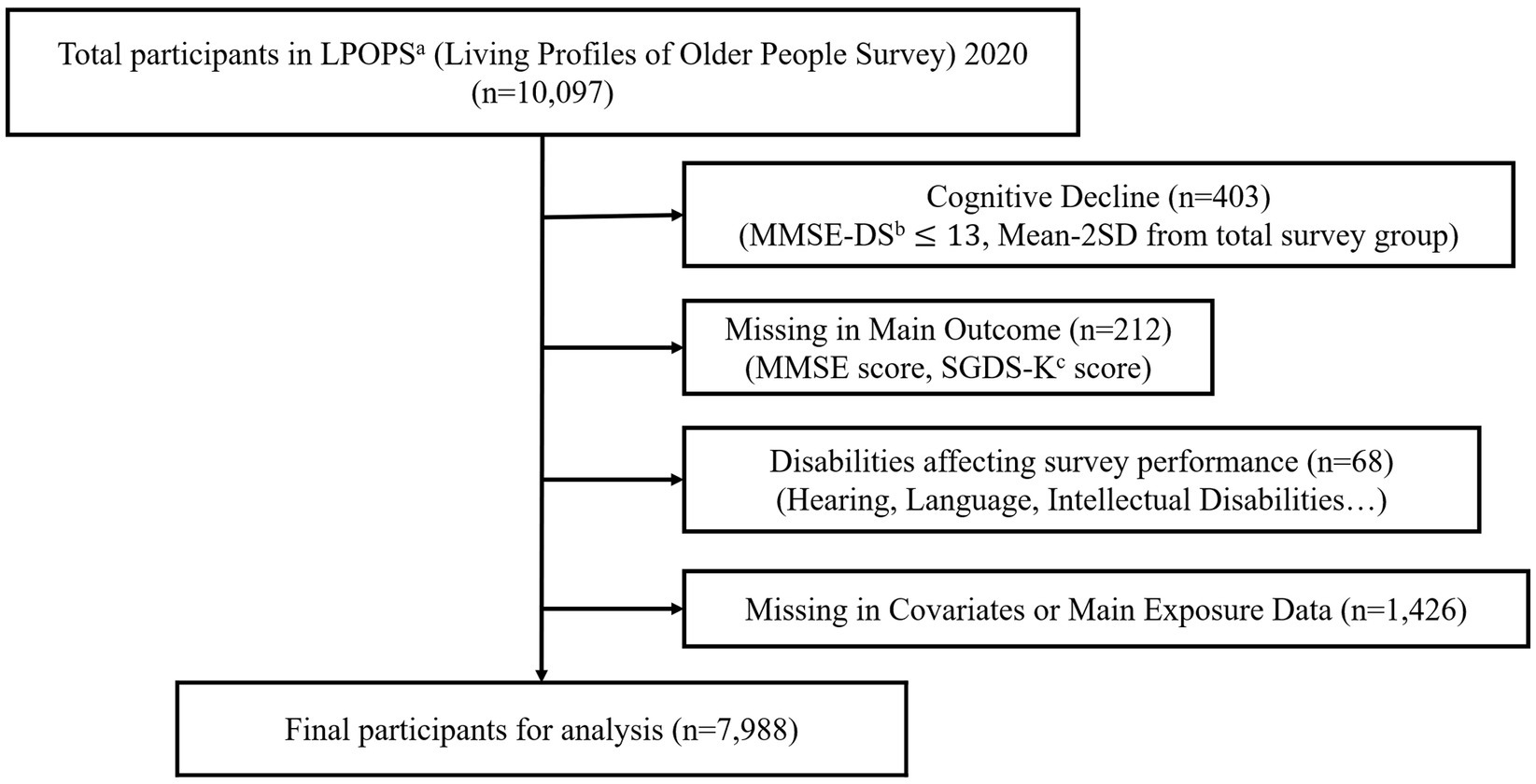
Figure 1. Flow chart of study participants. aLPOPS, Living Profiles of Old People Survey. bMMSE-DS, Mini-Mental State Examination—Dementia Screening. cSGDS-K, Short Geriatric Depression Scale of Korean version.
2.2. Assessment and measurements
2.2.1. Digital literacy
Digital literacy has been defined as an umbrella framework for several complex and integrated literacies comprising skills, knowledge, ethics, and creative output in the digital network environment (20, 21).
Digital literacy includes “communication literacy,” “information literacy,” “media literacy,” and “online transaction literacy.” We defined four digital literacy sub-items using questions from the Living Profiles of Older People Survey (LPOPS) (22, 23).
The “communication literacy” domain is characterized by the capacity to send and receive messages using digital devices. Its assessment utilized the questions: “Can you receive messages using devices such as a PC, mobile phone, or tablet?” and “Can you send messages utilizing the same devices?” Those respondents who affirmed their proficiency in both these tasks were deemed “literate” in this domain, while those who were unable to complete one or both tasks were labeled “illiterate.”
The domain of “information literacy” pertains to the skill of searching for and retrieving information online through digital devices. It was gaged through the query: “Can you search for and view specific information (e.g., news, weather) using a PC, mobile phone, or tablet?” Participants who attested to their capability in this regard were labeled “literate,” while others were termed “illiterate.”
“Media literacy” encompasses the proficiency to engage with varied media content, such as listening to music or watching videos, via digital means. Assessment questions included: “Can you listen to music (e.g., MP3, radio) through devices like a PC, mobile phone, or tablet?” and “Can you watch content (e.g., movies, TV shows, YouTube) on these devices?” Respondents proficient in both activities were categorized as “literate” within this domain, while those lacking in one or both were considered “illiterate.”
Lastly, “online transaction literacy” is defined by the ability to execute reservations or financial transactions digitally. It was evaluated using the questions: “Can you use devices like a PC, mobile phone, or tablet for electronic transactions (e.g., online shopping, ticketing, reservations)?” and “Can you conduct financial operations (e.g., internet banking, securities) using these devices?” Respondents affirming their proficiency in both were deemed “literate,” whereas those unable to perform one or both tasks were categorized as “illiterate” in this domain.
2.2.2. Depressive symptoms
Short Geriatric Depression Scale of Korean version (SGDS-K) was used to assess depressive symptoms (24). The SGDS-K comprises 15 binary questions that evaluate the presence of depressive and non-depressive symptoms. The scores on this scale range from 0 to 15, with higher scores indicating more severe geriatric depressive symptoms.
2.2.3. Cognitive function
Cognitive function was evaluated using the MMSE-DS. It was developed to address the limitations of K-MMSE and provide an accurate dementia screening tool that reflects the cultural and demographic characteristics of the older adult population in Korea (25). The MMSE-DS includes items that assess orientation, memory registration and recollection, concentration, naming, language, understanding, and judgment, with scores ranging from 0 to 30; higher scores indicate higher cognitive function. This study used a cutoff score of 13 or lower to define cognitive impairment based on a community-based survey (i.e., the mean-2 SD of the total subjects). The test was administered according to standard guidelines developed during the development of the tool to ensure consistency in implementation. The reliability (Cronbach’s alpha = 0.83) and validity of the MMSE-DS have been previously established.
2.2.4. Covariates
The covariates assessed in this study were age, sex, marital status, employment status, hobbies, years of education, current smoking, and the number of chronic diseases diagnosed by physicians. Years of education were divided into four groups: no education, 1–6 years, 7–12 years, and more than 13 years of education. A number of chronic diseases were defined as the number of chronic diseases diagnosed by a physician. These include cardiovascular, endocrine, musculoskeletal, pulmonary, neuropsychiatric, eye, ear, dermatologic, gastrointestinal, genitourinary, and other diseases.
2.3. Statistical analysis
The study utilized means and standard deviations for numerical variables and percentages and numbers for categorical variables. Depressive symptoms, measured using the total SGDS-K score, and cognitive function, measured using the total MMSE score, were continuous variables. A multiple linear regression analysis was conducted to examine the relationships among digital literacy, depressive symptoms, and cognitive function after adjusting for variables, such as age, sex, education level, marital status, and employment status. The analyses utilized Hayes’s (26) PROCESS plug-in program, which implements an ordinary least squares regression model and a bootstrap method to assess the statistical significance of the mediation and moderation effects. Specifically, the study utilized Model 4 to simultaneously investigate the relationships among digital literacy, cognitive function, and depressive symptoms, and 10,000 bootstrap samples were used to estimate the indirect effects of the mediating variables. Statistical significance was set at p < 0.05. All analyses were conducted using IBM SPSS v23.0 (SPSS Inc., Chicago, IL, United States).
3. Results
3.1. General characteristics of participants
The general characteristics of the study participants are presented in Table 1. The mean age of the participants was 73.4 years (Standard Deviation, SD = 6.1); 67.1% were male, and 32.9% were female. The mean number of hours spent using digital devices was 1.24 (SD = 1.2). The mean SGDS-K was 3.1 (SD = 3.2). The mean MMSE score was 25.3 (SD = 3.9).
3.2. Classification of participants according to types of digital literacy
This study assessed participants’ digital literacy in four areas: communication, information, media, and online transaction. The distribution of participants across each domain is displayed in Table 2 as numbers and percentages. Among the participants, 70.0% were illiterate in communication, 62.8% were illiterate in information, 40% were illiterate in media, and 13.7% were illiterate in online transaction.
3.3. Association of digital literacy with depressive symptoms
To evaluate the robustness of the correlations and their effect sizes while controlling for possible covariates, we conducted a multiple linear regression analysis. Compared to illiterate individuals, those who were literate in media and online transaction had fewer depressive symptoms (β = −0.702, 95% CI = −0.858 to −0.54, value of p < 0.001, and β = −0.639, 95% CI = −0.853 to −0.425, value of p < 0.001, respectively). More detailed information is provided in Table 3.
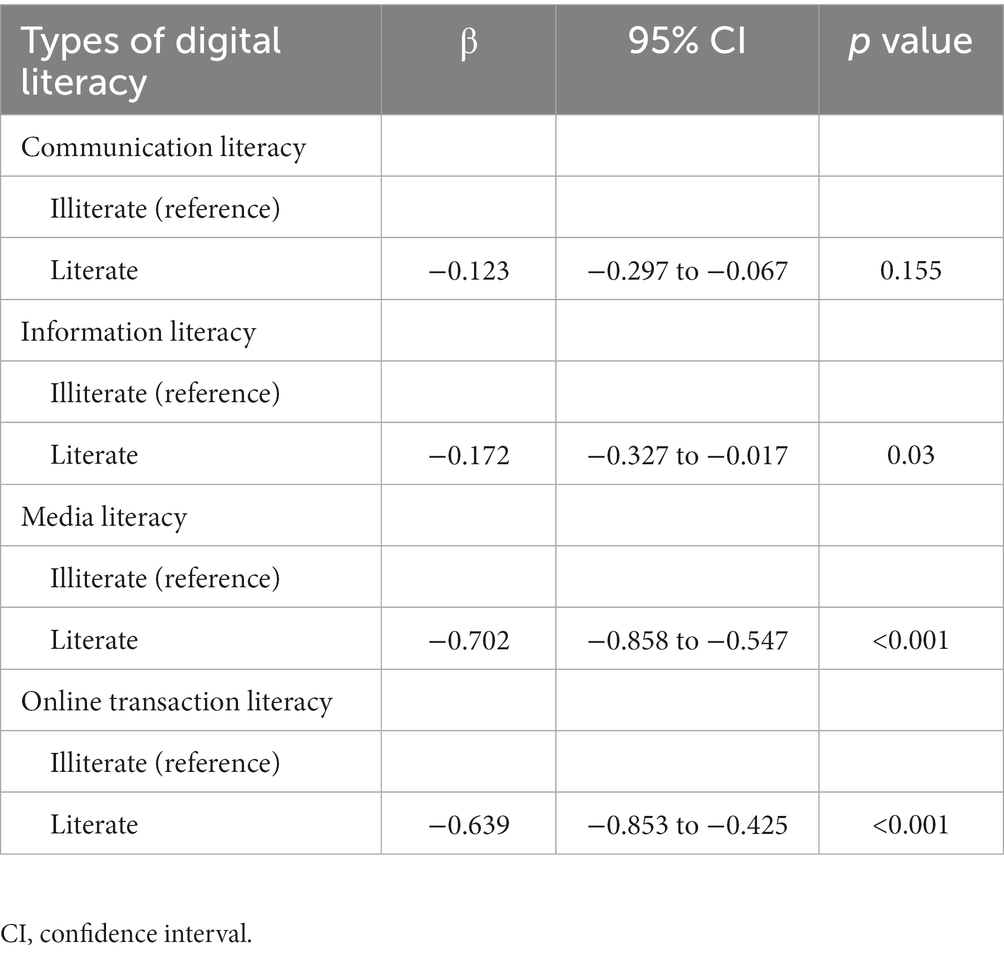
Table 3. Multiple linear regression analysis for association of digital literacy with depressive symptoms (n = 7,988).
3.4. Association of digital literacy with cognitive functions
The subtypes of digital literacy were associated with varied levels of cognitive function. Among those with high communication literacy, interactive communication using digital devices was positively associated with cognitive function (β = 2.102, 95% CI = 1.906–2.298, value of p < 0.001). Similarly, individuals with high information literacy who searched for news using digital devices showed a positive association with cognitive function (β = 2.217, 95% CI = 2.038–2.396, value of p < 0.001), and those with high media literacy who listened to music and watched videos using digital devices also showed an association with higher cognitive function (β = 1.711, 95% CI = 1.532–1.890, value of p < 0.001). Furthermore, individuals with high online transaction literacy who engaged in online banking and reservations using digital devices had higher cognitive function (β = 1.436, 95% CI = 1.198–1.675, value of p < 0.001). More detailed information is provided in Table 4.
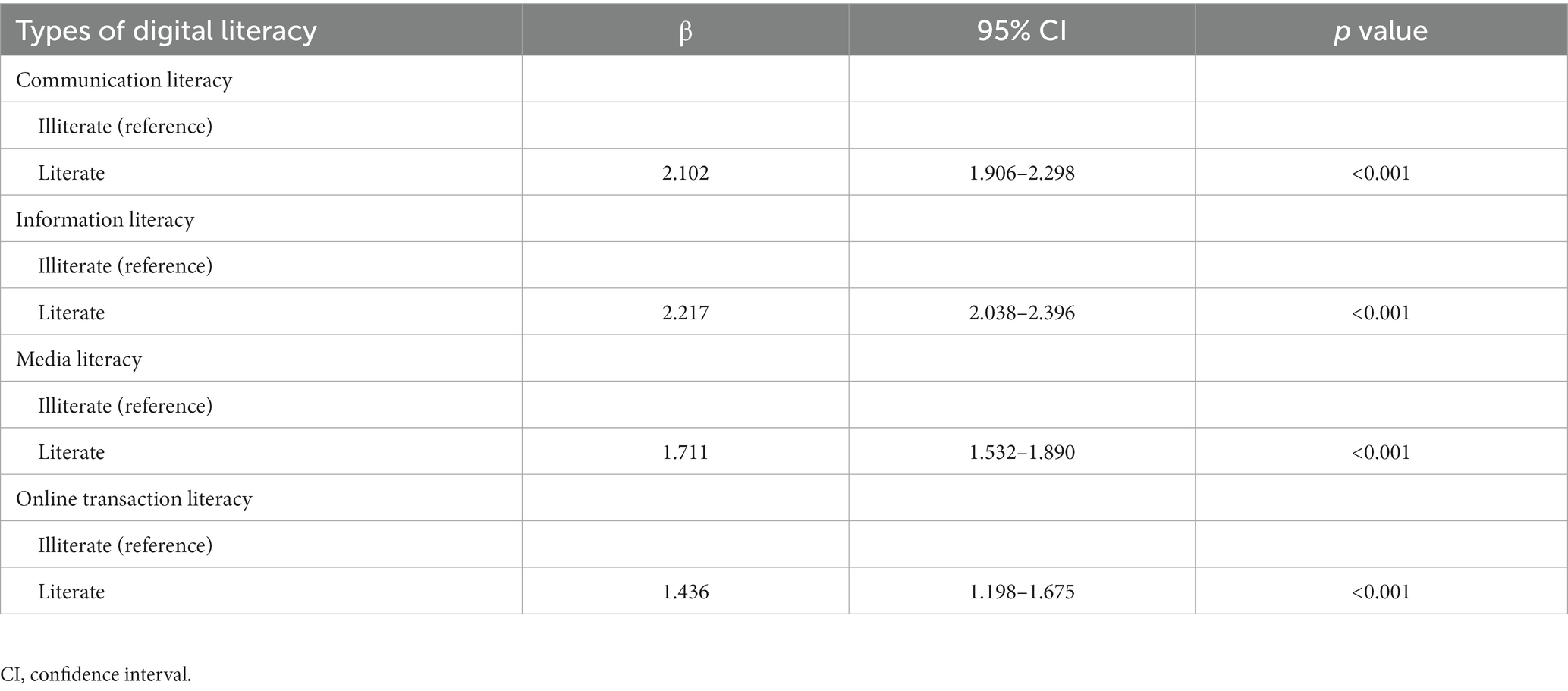
Table 4. Multiple linear regression analysis for association of digital literacy with cognitive function (n = 7,988).
3.5. Mediating effect of depressive symptoms on the association between digital literacy and cognitive function
Our results revealed that depressive symptoms significantly mediated the association between several subcategories of digital literacy and cognitive function, thereby suggesting an indirect pathway (digital literacy ➔ depressive symptoms ➔ cognitive function). Media and online transaction literacy had an indirect effect on cognitive function mediated by depressive symptoms (indirect effect = 0.0916, 95% CI = 0.0647–0.1212; indirect effect = 0.0938, 95% CI = 0.0639–0.1277, respectively). More detailed information is provided in Table 5.
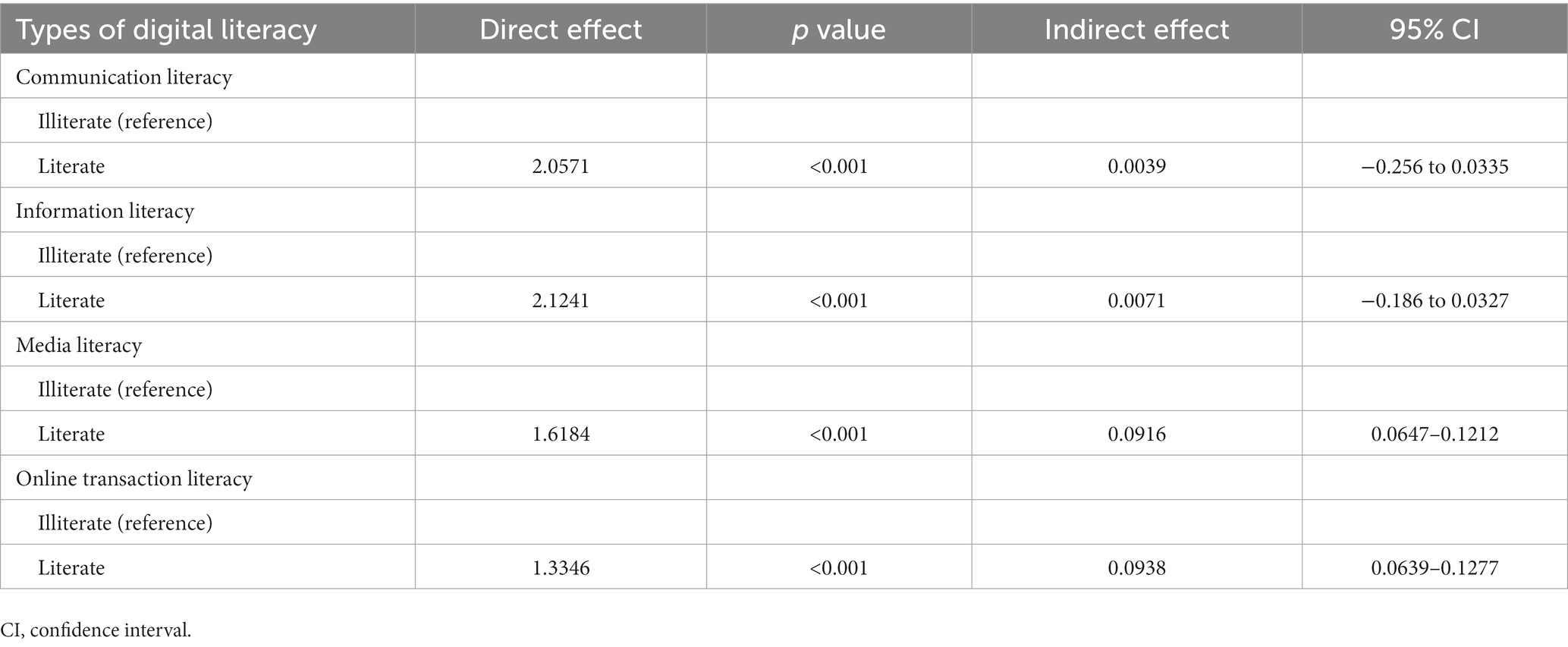
Table 5. Mediating effect of depressive symptoms on the association between digital literacy and cognitive function (n = 7,988).
4. Discussion
This study examined the interdependent associations among digital literacy, depressive symptoms, and cognitive function in older adults. We found that media literacy and online transaction literacy were associated with lower depressive symptoms in older adults, while communication literacy and information literacy were not significantly associated with lower depressive symptoms. Additionally, all four literacy types (communication, information, media, and online transaction literacy) were associated with higher cognitive function. These four literacies also demonstrated a direct effect on cognitive function. Furthermore, while the influence of digital literacy on depression and cognitive function can be complex, our analysis showed that media literacy and online transaction literacy indirectly affected cognitive function through a pathway mediated by depressive symptoms (digital literacy ➔ depressive symptoms ➔ cognitive function), whereas communication and information literacy did not exhibit this pattern.
Among the four types of digital literacy, communication and information literacy were not significantly associated with fewer depressive symptoms, which differs from the results of previous research (27). This may be due to the limited scope of digital communication or the unspecified identity of the interlocutors, which could have resulted in negative interactions. The study also lacked specificity regarding the type of news the participants were exposed to in the assessment of information literacy, which could have affected the results (21). In contrast, media and online transaction literacy were associated with fewer depressive symptoms, which is consistent with a previous study (28). This could be due to the consumption of positive content and social connectedness provided by media literacy, as well as the self-efficacy and self-mastery associated with online transaction literacy (29).
All four types of digital literacy (communication, information, media, and online transaction literacy) were significantly associated with higher cognitive function in older adults. This finding is consistent with those of previous studies (30). A possible mechanism is that digital literacy enhances cognitive function and brain plasticity in older adults by activating brain regions related to executive function, memory, and language processing and by modulating the negative effects of aging on brain activation (31, 32).
This study highlights the mediating role of depressive symptoms in the association between digital literacy and cognitive function among older adults. Building on prior research linking depression with cognitive decline, we propose a potential mechanism: enhanced digital literacy might alleviate depressive symptoms by reducing feelings of isolation, which in turn could improve cognitive function. Furthermore, digital literacy has both an indirect influence, through depressive symptoms, and a direct influence on cognitive function. This observation supports the idea that depressive symptoms partially mediate the relationship, underscoring their pivotal role in the dynamic interplay among digital literacy, cognitive function, and these symptoms.
However, our analysis also revealed a statistically significant reverse pathway: cognitive function influences depressive symptoms, which then affect digital literacy, suggesting a bidirectional relationship. While the primary pathway aligns with previous studies and is of notable interest, the reverse also warrants attention. To delineate the precise dynamics between these variables, a longitudinal follow-up study is crucial. The results reinforce our primary hypothesis, but also underscore the importance of further exploration into the potential bidirectionality of these associations.
To our knowledge, this is the first study employing a mediation model to investigate this relationship. These findings can guide the creation of interventions like community-based digital literacy programs. Such programs aim not only to boost the digital literacy and cognitive health of older adults but also to showcase their effectiveness.
The limitation of this study is its cross-sectional design, which prevents the assessment or confirmation of causal relationships between digital literacy and brain activation. Additionally, this study measured depressive symptoms based on a self-reported survey, which may not reflect the actual severity or duration of the participant’s symptoms. Second, this study adopted a vague definition of “digital literacy,” which lacked details about the types of communication and information relevant for assessing communication and information literacy. Lastly, although we controlled for all available confounders in our analysis, some unmeasured confounders could not be accounted for owing to data limitations. Nonetheless, this study has several strengths. First, the participants were recruited from a relatively large nationwide longitudinal community-based survey in Korea. Second, in addition to controlling for established or potential demographic predictors of depression, we considered clinically relevant factors such as tobacco and alcohol use, comorbid conditions, and disabilities.
In conclusion, media and online transaction literacy were associated with fewer depressive symptoms in older adults. All four digital literacy types were associated with higher cognitive function, and depressive symptoms act as mediators between certain dimensions of digital literacy (e.g., online transaction and media literacy) and cognitive functions. These findings are valuable for the development of effective interventions or public campaigns aimed at reducing depression and cognitive impairment from a targeted community mental health perspective.
Data availability statement
The raw data supporting the conclusions of this article will be made available by the authors, without undue reservation.
Ethics statement
The studies involving humans were approved by Ajou University Hospital’s Institutional Review Board. The studies were conducted in accordance with the local legislation and institutional requirements. The participants provided their written informed consent to participate in this study.
Author contributions
JH: conceptualization, writing—original draft, and formal analysis. YN and SH: writing—review, editing, methodology, funding acquisition, and supervision. HR: conceptualization, methodology, investigation, writing—original draft, and formal analysis. All authors contributed to the article and approved the submitted version.
Funding
This work was supported by the Korea Health Technology R&D Project through the Korea Health Industry Development Institute (KHIDI), funded by the Ministry of Health & Welfare, Republic of Korea (grant number: HI22C0724 and HR22C173405).
Conflict of interest
The authors declare that the research was conducted in the absence of any commercial or financial relationships that could be construed as a potential conflict of interest.
Publisher’s note
All claims expressed in this article are solely those of the authors and do not necessarily represent those of their affiliated organizations, or those of the publisher, the editors and the reviewers. Any product that may be evaluated in this article, or claim that may be made by its manufacturer, is not guaranteed or endorsed by the publisher.
Abbreviations
LPOPS, Living profiles of older people survey; SD, Standard deviation; MMSE, Mini-mental state examination; MMSE-DS, Mini-mental state examination-dementia screening; SGDS-K, Short geriatric depression scale of Korean version.
References
1. Prince, M , Bryce, R , Albanese, E , Wimo, A , Ribeiro, W , and Ferri, CP . The global prevalence of dementia: a systematic review and metaanalysis. Alzheimers Dement. (2013) 9:e62. doi: 10.1016/j.jalz.2012.11.007
2. Arvanitakis, Z , Shah, RC , and Bennett, DA . Diagnosis and Management of Dementia: review. JAMA. (2019) 322:1589–99. doi: 10.1001/jama.2019.4782
3. Lin, FR , Yaffe, K , Xia, J , Xue, QL , Harris, TB , Purchase-Helzner, E, et al. Hearing loss and cognitive decline in older adults. JAMA Intern Med. (2013) 173:293–9. doi: 10.1001/jamainternmed.2013.1868
4. Jin, Y , Jing, M , and Ma, X . Effects of digital device ownership on cognitive decline in a middle-aged and elderly population: longitudinal observational study. J Med Internet Res. (2019) 21:e14210. doi: 10.2196/14210
5. Konok, V , and Szőke, R . Longitudinal associations of children’s hyperactivity/inattention, peer relationship problems and mobile device use. Sustain For. (2022) 14:8845. doi: 10.3390/su14148845
6. Limniou, M . The effect of digital device usage on student academic performance: a case study. Educ Sci. (2021) 11:121. doi: 10.3390/educsci11030121
7. Ellison, NB , Steinfield, C , and Lampe, C . The benefits of Facebook “friends:” social capital and college students’ use of online social network sites. J Comput-Mediat Commun. (2007) 12:1143–68. doi: 10.1111/j.1083-6101.2007.00367.x
8. Hampton, KN , Sessions, LF , and Her, EJ . Core networks, social isolation, and new media. Inf Commun Soc. (2011) 14:130–55. doi: 10.1080/1369118X.2010.513417
9. Nikolin, S , Tan, YY , Martin, D , Moffa, A , Loo, CK , and Boonstra, TW . Behavioural and neurophysiological differences in working memory function of depressed patients and healthy controls. J Affect Disord. (2021) 295:559–68. doi: 10.1016/j.jad.2021.08.083
10. Yost, JH , and Weary, G . Depression and the correspondent inference Bias: evidence for more effortful cognitive processing. Personal Soc Psychol Bull. (1996) 22:192–200. doi: 10.1177/0146167296222008
11. Lee, MA , Ferraro, KF , and Kim, G . Digital technology use and depressive symptoms among older adults in Korea: beneficial for those who have fewer social interactions? Aging Ment Health. (2021) 25:1839–47. doi: 10.1080/13607863.2020.1839863
12. Hu, T , Zhao, X , Wu, M , Li, Z , Luo, L , Yang, C, et al. Prevalence of depression in older adults: a systematic review and meta-analysis. Psychiatry Res. (2022) 311:114511. doi: 10.1016/j.psychres.2022.114511
13. Sivertsen, H , Bjorklof, GH , Engedal, K , Selbaek, G , and Helvik, AS . Depression and quality of life in older persons: a review. Dement Geriatr Cogn Disord. (2015) 40:311–39. doi: 10.1159/000437299
14. Cebollero-Salinas, A , Cano-Escoriaza, J , and Orejudo, S . Are emotional e-competencies a protective factor against habitual digital behaviors (media multitasking, cybergossip, phubbing) in Spanish students of secondary education? Comput Educ. (2022) 181:104464. doi: 10.1016/j.compedu.2022.104464
15. Bae, SM . The mediating effect of digital literacy on the relationship between smartphone use motives and life satisfaction for senior citizens in Korea. Iran J Public Health. (2022) 51:336–44. doi: 10.18502/ijph.v51i2.8686
16. Durán, L , Almeida, AM , and Figueiredo-Braga, M . Digital audiovisual contents for literacy in depression: a pilot study with university students. Proc Comput Sci. (2021) 181:239–46. doi: 10.1016/j.procs.2021.01.140
17. Gallagher, D , Kiss, A , Lanctot, K , and Herrmann, N . Depressive symptoms and cognitive decline: a longitudinal analysis of potentially modifiable risk factors in community dwelling older adults. J Affect Disord. (2016) 190:235–40. doi: 10.1016/j.jad.2015.09.046
18. Kohler, S , van Boxtel, MP , van Os, J , Thomas, AJ , O'Brien, JT , Jolles, J, et al. Depressive symptoms and cognitive decline in community-dwelling older adults. J Am Geriatr Soc. (2010) 58:873–9. doi: 10.1111/j.1532-5415.2010.02807.x
19. Lin, L , Jing, XC , Lv, SJ , Liang, JH , Tian, L , Li, HL, et al. Mobile device use and the cognitive function and depressive symptoms of older adults living in residential care homes. BMC Geriatr. (2020) 20:41. doi: 10.1186/s12877-020-1427-1
20. Covello, S . A Review of Digital Literacy Assessment Instruments. New York (Syracuse): Syracuse University (2010).
21. de Hoog, N , and Verboon, P . Is the news making us unhappy? The influence of daily news exposure on emotional states. Br J Psychol. (2020) 111:157–73. doi: 10.1111/bjop.12389
22. Nguyen, LAT , and Habók, A . Tools for assessing teacher digital literacy: a review. J Comput Educ. (2023). doi: 10.1007/s40692-022-00257-5
23. Tinmaz, H , Lee, Y-T , Fanea-Ivanovici, M , and Baber, H . A systematic review on digital literacy. Smart Learn Environ. (2022) 9:21. doi: 10.1186/s40561-022-00204-y
24. Bae, JN , and Cho, MJ . Development of the Korean version of the geriatric depression scale and its short form among elderly psychiatric patients. J Psychosom Res. (2004) 57:297–305. doi: 10.1016/j.jpsychores.2004.01.004
25. Kim, TH , Jhoo, JH , Park, JH , Kim, JL , Ryu, SH , Moon, SW, et al. Korean version of mini mental status examination for dementia screening and its' short form. Psychiatry Investig. (2010) 7:102–8. doi: 10.4306/pi.2010.7.2.102
26. Hayes, AF . Introduction to mediation, moderation, and conditional process analysis: a regression-based approach. New York, US: Guilford Press. (2018). Available at: https://psycnet.apa.org/record/2013-21121-000
27. Nakagomi, A , Shiba, K , Kondo, K , and Kawachi, I . Can online communication prevent depression among older people? A longitudinal analysis. J Appl Gerontol. (2022) 41:167–75. doi: 10.1177/0733464820982147
28. Yoo, J , Oh, J , Kim, SY , Shin, J , Kim, S , and Roh, C . Impact of digital device, exercise, and music intervention programs on the cognition and depression of the elderly in South Korea: a meta-regression analysis. Int J Environ Res Public Health. (2022) 19:4036. doi: 10.3390/ijerph19074036
29. Adiasto, K , Beckers, DGJ , van Hooff, MLM , Roelofs, K , and Geurts, SAE . Music listening and stress recovery in healthy individuals: a systematic review with meta-analysis of experimental studies. PLoS One. (2022) 17:e0270031. doi: 10.1371/journal.pone.0270031
30. Scullin, MK , Jones, WE , Phenis, R , Beevers, S , Rosen, S , Dinh, K, et al. Using smartphone technology to improve prospective memory functioning: a randomized controlled trial. J Am Geriatr Soc. (2022) 70:459–69. doi: 10.1111/jgs.17551
31. Lee, H , Lim, JA , and Nam, HK . Effect of a digital literacy program on older adults' digital social behavior: a quasi-experimental study. Int J Environ Res Public Health. (2022) 19:12404. doi: 10.3390/ijerph191912404
Keywords: cognitive function, depressive symptoms, digital literacy, mediating effect, older adults
Citation: Hong JW, Nam YJ, Hong S and Roh HW (2023) Mediating effect of depressive symptoms on the relationship between digital literacy and cognitive function in older adults. Front. Psychiatry. 14:1248347. doi: 10.3389/fpsyt.2023.1248347
Edited by:
Wei Liang, Shenzhen University, ChinaReviewed by:
Huaxuan Liu, Fujian Normal University, ChinaMin Hyuk Kim, Yonsei University, Republic of Korea
Copyright © 2023 Hong, Nam, Hong and Roh. This is an open-access article distributed under the terms of the Creative Commons Attribution License (CC BY). The use, distribution or reproduction in other forums is permitted, provided the original author(s) and the copyright owner(s) are credited and that the original publication in this journal is cited, in accordance with accepted academic practice. No use, distribution or reproduction is permitted which does not comply with these terms.
*Correspondence: Sunhwa Hong, c2g5QGFqb3UuYWMua3I=; Hyun Woong Roh, aGFuc2luODYwN0Bham91LmFjLmty
†These authors have contributed equally to this work
 Jae Woo Hong
Jae Woo Hong You Jin Nam2†
You Jin Nam2† Hyun Woong Roh
Hyun Woong Roh